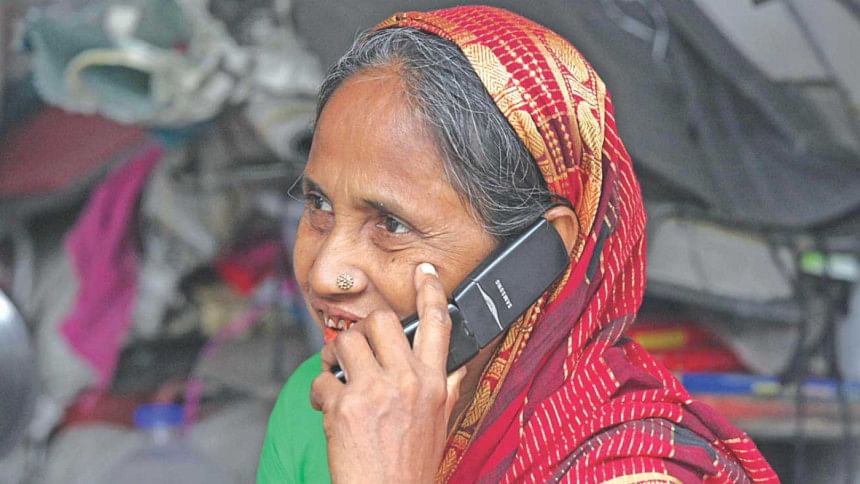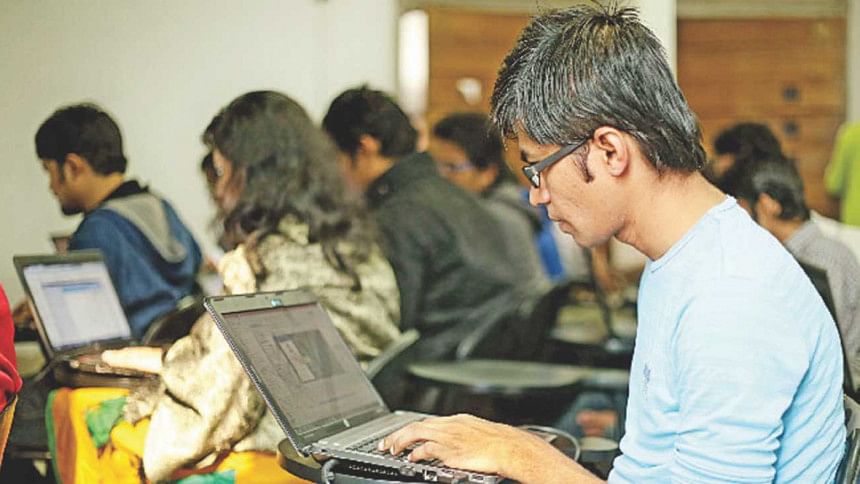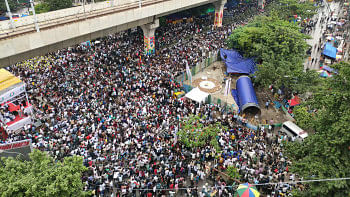Digital Bangladesh: Dreams and reality

Digital Bangladesh is one of the nation's dreams, and so special emphasis is given on the application of digital technologies to realise Vision 2021, which we commonly call Digital Bangladesh. By 2021, after 50 years of independence, our goal is to be a middle-income country with peace, prosperity and dignity. The government of Bangladesh implemented a large number of projects relating to digital technologies and a number of these are already underway. National ICT Policy-2009 was developed with a view to achieve middle-income status of the nation by 2021 and developed status by 2041.
The World Bank classifies economies as low-income, middle-income and high-income groups. The Per Capita Gross National Income (GNI) is the basis of the classification. Low-income and middle-income countries are referred to as developing countries. Per Capita GNI is the dollar value of a country's income in a year, divided by its population. As of July 1, 2014, low-income economies are defined (in 2013) as those with GNI per capita of USD 1,045 or less (World Bank Atlas Method) and middle-income economies with a GNI per capita above USD 1,045 (but less than USD 12,746). (According to this classification of the Word Bank, Bangladesh should be very close to the middle-income group now and our target should be the upper middle-income group by 2021.)
According to the National ICT Policy-2009, short-term, mid-term and long-term plans consisting of 306 action plans have been identified for the realisation of Vision 2021. Digital Bangladesh is an issue regarding which there is no conflict or difference of opinion between the government and the people – all are working hand-in-hand for its realisation. This short article briefly summarises our achievements in ICT, examines our status in the global perspective, and suggests steps to be taken in light of the recent advancements in ICT.

Achievements
The slogan of “Digital Bangladesh” of the Government of Bangladesh has special significance for national development. Digital Bangladesh with Vision 2021 is a big impetus for the use of digital technology in the country. In spite of several bottlenecks and limitations, works are in progress for the realisation of Digital Bangladesh. Several projects for digitalisation have been completed and a big number of projects are under progress. The nation now, with over 12 crore mobile subscribers and 4.3 crore Internet subscribers, enjoys the fruits of digitisation in numerous areas of activities. The ultimate objective is to make more and more services available at the doorsteps of the people with increased digitalisation where possible.
A few examples of available digital services are: registration for admission to academic institutions, publication of results of examinations, registration for jobs abroad, registration of pilgrimage, collection of official forms, online submission of tax returns, online tendering, etc. Online banking systems have sped up the financial activities of the country. SMS services for lodging complaints to police stations, online bill payments for utility services, instant communication with persons working abroad, and e-passports are some more examples.
Telemedicine services, videoconferencing for the treatment of diseases, and video conferencing for administrative activities are examples of e-services available to rural Bangladesh. Setting up of nearly five thousand Union Information Service Canters is a great boost for Digital Bangladesh, especially for rural areas. Turning eight thousand village post offices and approximately five hundred upazila post offices into e-centers and the introduction of mobile money order and postal cash cards are significant achievements in the recent past. Union Information Centers, District Information Cells, National Information Cell are also revolutionary additions.
There are many more developments in the line. Deputy Commissioner Offices in districts and UNO offices in upazilas provide a large number of e-services to rural clients. Direct digital services eliminate middlemen and save both time and money. Without such online services, our cities and towns would have turned into difficult places to live in.
Status and Ranking
In spite of mentionable achievements in the recent past, our position as providers and users of ICT services is far behind many countries. This can be explained by the benchmarking indices of responsible international organisations like the United Nations, World Economic Forum, International Telecommunication Union, etc.
Networked Readiness Index (NRI)
The Networked Readiness Index (NRI) of the World Economic Forum assesses the impact of ICT on the competitiveness of the nations of the world. The four sub-indices of NRI are: Environment (business, innovation, political and regulatory), Readiness (infrastructure, digital contents, affordability, skills), Usage (individuals, businesses and government), and finally the Impact of ICT (economic and social impact). Each sub-index is based on several pillars (a total of 10) and each pillar is calculated out of a number of indicators. For example, the Environment sub-index is based on two pillars: a) political and regulatory environment, and b) business and innovation environment; the score of political and regulatory environment pillar is calculated out of numerical values of nine indicators.
Table 1: Status of NRI of Bangladesh and its neighboring countries
| COUNTRY | 2014 | 2013 | 2012 |
| Bangladesh | 119 (score 3.21) | 114 | 113 |
| Bhutan | 94 (score 3.68) | N/A | N/A |
| India | 83 (score 3.85) | 68 | 69 |
| Nepal | 123 (score 3.09) | 126 | 128 |
| Pakistan | 111 (score 3.33) | 105 | 102 |
| Sri Lanka | 76 (score 3.94) | 69 | 71 |
Table 1 depicts the NRI status of Bangladesh and its neighboring countries. Bangladesh's global position (with a score of 3.21 out of 10) is 119 (out of 144 countries) in 2014, which is five steps below its 114th position in 2013. This was due to poor performance in the Environment, Impact and Usage sub-indices compared to other nations. According to the 2014 NRI rankings, the ranks of India (3.85), Pakistan (3.33) and Sri Lanka (3.94) have also degraded. On the other hand, Nepal (3.09) moved up by three positions to 123 from 126. This indicates our achievements in ICT and current status of digital lifestyle in global perspective.
According to the NRI data of 2014, the top 10 countries are: Finland (6.04), Singapore (5.97), Sweden (5.93), Netherlands (5.79), Norway (5.70), Switzerland (5.62), United States (5.61), Hong Kong (5.60), United Kingdom (5.54) and Korea Republic (5.54). Bangladesh needs to improve in the Environment Readiness sub-indices. The public sector of Bangladesh scores higher in the Usage sub-index than the private sector. We need to increase individual usage of ICT besides infrastructure and digital contents for increasing social and economic impact.
ICT Development Index (IDI)
The ICT Development Index (IDI) of the International Telecommunication Union (ITU) is a useful tool for the status of Information Society. This index, which is based on eleven indicators, is grouped into three categories: Access, Use and Skills. Table 2 depicts the IDI of Bangladesh and its neighboring countries according to the Information Society Report 2014 of ITU. In the 2013 IDI ranking, Bangladesh is ranked 145 and is ahead of Afghanistan and Myanmar amongst our South Asian neighbors. Currently Sri Lanka, ranked 116, is at the highest position in the region. Among the 29 countries of Asia and the Pacific listed in the report, Bangladesh's position is third from the bottom. The bottom two countries are Afghanistan and Myanmar. Bangladesh needs special attention for improvement in the Use sub-category (score of 0.27, rank 150), Access sub-index (score of 2.5, rank 143) as well as the quick expansion of broadband wireless Internet services. However, the good news is that Bangladesh offers mobile cellular services at a lower cost than many countries of the world.
Table 2: Status of IDI of Bangladesh and its neighboring countries
| COUNTRY | 2013 | 2012 | 2011 |
| Afghanistan | 155 (score 1.67) | 155 | N/A |
| Bangladesh | 145 (score 1.97) | 146 | 139 |
| India | 129 (score 2.53) | 129 | 120 |
| Nepal | 131 (score 2.37) | 134 | N/A |
| Pakistan | 142 (score 2.05) | 141 | 128 |
| Bhutan | 123 (score 2.85) | 126 | 117 |
| Sri Lanka | 116 (score 3.24) | 113 | 107 |
| Myanmar | 150 (score 1.82) | 148 | N/A |
In the IDI ranking of 2013, the top 10 countries (with scores out of 10) are: Denmark (8.86), Korea Republic (8.85), Sweden (8.67), Iceland (8.64), UK (8.50), Norway (8.39), Netherlands (8.38), Finland (8.31), Hong Kong (8.28) and Luxemburg (8.26).
E-Government Development Index (EGDI)
United Nation's e-Government Development Index (EGDI) evaluates the impact of ICT on the political economy of a country. This index focuses on how governments use ICT to deliver services to the people and opportunities for citizens to participate in the decision-making process. EGDI is measured on the basis of online services, technological infrastructure and human capital. Table 3 shows Bangladesh's ranking (out of a total of 193 countries) in EGDI as wells as those of its neighbouring countries. Amongst the South Asian countries, Bangladesh (rank 148) is ahead of Afghanistan (rank 173), Nepal (rank 165), Pakistan (rank 158) and Myanmar (rank 175). Ranked at 74, Sri Lanka is at the highest position in the region.
Table-3: EGDI ranking of Bangladesh and its neighboring countries
| COUNTRY | 2014 | 2012 | 2010 |
| Afghanistan | 173 (score 0.1900) | 184 | 168 |
| Bangladesh | 148 (score 0.2757) | 150 | 134 |
| Bhutan | 143 (score 0.2829) | 152 | 152 |
| India | 118 (score 0.3834) | 125 | 119 |
| Maldives | 94 (score 0.4813) | 95 | 92 |
| Myanmar | 175 (score 0.1869) | 160 | 141 |
| Nepal | 165 (score 0.2344) | 164 | 153 |
| Pakistan | 158 (score 0.2580) | 156 | 146 |
| Sri Lanka | 74 (score 0.5418) | 115 | 111 |
The top 10 countries (with a score out of 1) are: Republic of Korea (0.9462), Australia (0.9103), Singapore (0.9076), France (0.8938), Netherlands (0.8897), Japan (0.8874), USA (0.8748), UK (0.8695), New Zealand (0.8644) and Finland (0.8449).
According to a UN report, the least developed countries (LDCs) with significant progress in mobile technology and mobile-government services (such as notification by SMS, mobile-banking and mobile-health services) are of special importance. Bangladesh (score of 0.2757 out of 1) is in the eighth position among 48 LDCs after Rwanda (0.3589), Kiribati (0.3201), Tuvalu (0.3059), Cambodia (0.2999), Angola (0.2970), Bhutan (0.2829) and Tanzania (0.2764).
Our rankings in the above mentioned indices (NRI, IDI and EGDI) are poor in comparison to most of the countries of the world.
ICT Trends
A noteworthy trend in ICT is that numerous devices with new and updated technologies are rapidly replacing older devices. New technologies for the near future include 3D printing, thumb printing, increased smartphone storage, expanded use of IPv6, broadband services for consumers, cloud computing, quantum computing, real-time speech transaction, nano-computers, wearable devices and networks, cyber security, smart cities, Internet of Things (IoT), etc. New trends, techniques and devices will massively involve online activities affecting our lifestyle. IoT interconnects all sensors and smart objects to interconnect in such a way as to make them intelligent, programmable and capable of interacting with humans.
More and more smart machines and processes will be required for decision-making in business, administration and education, and they will impact our lifestyle and the jobs of decision-makers significantly. All types of jobs, including business and administration, will be more and more digitised. We in Bangladesh will be forced to use and adapt new technologies and will require expertise in new technologies like cloud computing, 3D printing, Big Data, gaming, animation, outsourcing, etc.
Internet services require radical improvement in terms of speed. Starting from e-commerce, the internet is used for numerous applications and a higher speed for internet services is of great significance for rapid economic growth. Most nations of the world now give special emphasis on the improvement of Internet speeds. Average internet speed of users is above 10 Mbps in many countries (South Korea: 25.3 Mbps, Hong Kong: 16.03 Mbps, Japan: 15 Mbps).
It is encouraging that the ICT Division of the Ministry of Posts, Telecommunications and Information Technology has undertaken all-out efforts for the development of ICT human resources through countrywide training. Some examples of these trainings include Learning and Earning, Training for Mobile Apps, Leveraging ICT for Growth, Employment and Governance Project, and ITES Foundation Skills Training. Special emphasis is given to ICT education up to high school. Also, the ICT policy is being updated to face new trends. Ambitious projects like development of the National ICT Infrastructure for Bangladesh Government (Info Sarkar), National Data Centre and IT Parks will bring about radical improvements in e-services, e-governance and software development in the country.
Actions to be Taken
Bangladesh has an impressive track record of growth and development and aspires to achieve middle-income status by its 50th birthday. The country needs faster growth which depends on increased investments, development of human capital and enhanced productivity.
We have mentionable progress in ICT considering our previous condition. But keeping in mind our current rank and status in comparison with other nations and the rapid development of ICT, the journey ahead for Digital Bangladesh will not be smooth. Each new technology requires new skills and training. Human capital is a key factor to develop and adapt innovative ideas and technologies. Quality ICT education as well as ICT-based education from the primary to tertiary level, along with the orientation of general mass in ICT should receive top priority.
Elimination of the digital divide between rural and urban areas and between Bangladesh and other nations is essential in order to be at par with middle-income nations. A peaceful political environment is essential for intellectual, social, cultural and economic development. Time and time again, the nation's dream for Vision 2021 and Digital Bangladesh has been shattered by the turbulent political situation. The country dearly needs a tranquil political environment for the development of all sectors, including ICT, and for the realisation of Vision 2021 and Digital Bangladesh.
..................................................................
The writer is Vice Chancellor, Daffodil International University, Dhaka.

 For all latest news, follow The Daily Star's Google News channel.
For all latest news, follow The Daily Star's Google News channel. 



Comments